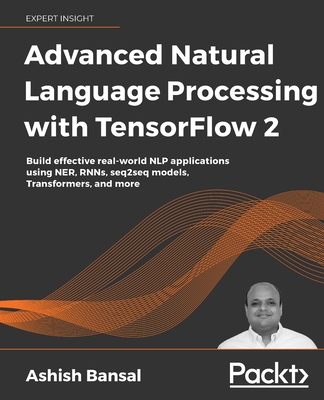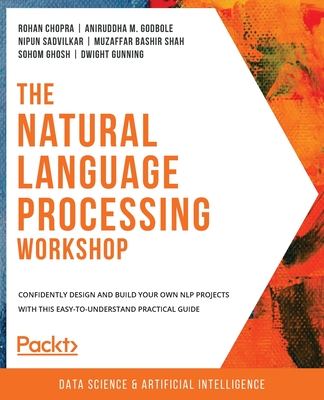Hands-On Natural Language Processing with PyTorch 1.x: Build smart, AI-driven linguistic applications using deep learning and NLP techniques
暫譯: 實作自然語言處理與 PyTorch 1.x:使用深度學習和 NLP 技術構建智能 AI 驅動的語言應用程式
Thomas Dop (Author)
- 出版商: Packt Publishing
- 出版日期: 2020-07-09
- 售價: $1,650
- 貴賓價: 9.5 折 $1,568
- 語言: 英文
- 頁數: 278
- 裝訂: Quality Paper - also called trade paper
- ISBN: 1789802741
- ISBN-13: 9781789802740
-
相關分類:
Natural Language Processing
海外代購書籍(需單獨結帳)
買這商品的人也買了...
商品描述
In the internet age, where an increasing volume of text data is generated daily from social media and other platforms, being able to make sense of that data is a crucial skill. With this book, you’ll learn how to extract valuable insights from text by building deep learning models for natural language processing (NLP) tasks.
Starting by understanding how to install PyTorch and using CUDA to accelerate the processing speed, you’ll explore how the NLP architecture works with the help of practical examples. This PyTorch NLP book will guide you through core concepts such as word embeddings, CBOW, and tokenization in PyTorch. You’ll then learn techniques for processing textual data and see how deep learning can be used for NLP tasks. The book demonstrates how to implement deep learning and neural network architectures to build models that will allow you to classify and translate text and perform sentiment analysis. Finally, you’ll learn how to build advanced NLP models, such as conversational chatbots.
By the end of this book, you’ll not only have understood the different NLP problems that can be solved using deep learning with PyTorch, but also be able to build models to solve them.
商品描述(中文翻譯)
在網際網路時代,社交媒體和其他平台每天產生大量的文本數據,能夠理解這些數據是一項至關重要的技能。通過本書,您將學習如何通過構建深度學習模型來提取文本中的有價值見解,以應對自然語言處理(NLP)任務。
本書將從理解如何安裝 PyTorch 和使用 CUDA 來加速處理速度開始,並通過實際範例探索 NLP 架構的運作方式。本書將指導您了解 PyTorch 中的核心概念,如詞嵌入(word embeddings)、CBOW 和標記化(tokenization)。接著,您將學習處理文本數據的技術,並了解深度學習如何應用於 NLP 任務。本書展示了如何實現深度學習和神經網絡架構,以構建模型,讓您能夠對文本進行分類、翻譯以及執行情感分析。最後,您將學習如何構建高級 NLP 模型,例如對話式聊天機器人。
在本書結束時,您不僅將理解可以使用 PyTorch 的深度學習解決的不同 NLP 問題,還能夠構建模型來解決這些問題。
作者簡介
Thomas Dop is a data scientist at MagicLab, a company that creates leading dating apps, including Bumble and Badoo. He works on a variety of areas within data science, including NLP, deep learning, computer vision, and predictive modeling. He holds an MSc in data science from the University of Amsterdam.
作者簡介(中文翻譯)
Thomas Dop 是 MagicLab 的數據科學家,該公司創建了包括 Bumble 和 Badoo 在內的領先約會應用程式。他在數據科學的多個領域工作,包括自然語言處理 (NLP)、深度學習、計算機視覺和預測建模。他擁有阿姆斯特丹大學的數據科學碩士學位。
目錄大綱
- Fundamentals of Machine Learning and Deep Learning
- Getting Started with PyTorch 1.x for NLP
- NLP and Text Embeddings
- Text Preprocessing, Stemming, and Lemmatization
- Recurrent Neural Networks and Sentiment Analysis
- Convolutional Neural Networks for Text Classification
- Text Translation using Sequence to Sequence Neural Networks
- Building a Chatbot Using Attention-based Neural Networks
- The Road Ahead
目錄大綱(中文翻譯)
- Fundamentals of Machine Learning and Deep Learning
- Getting Started with PyTorch 1.x for NLP
- NLP and Text Embeddings
- Text Preprocessing, Stemming, and Lemmatization
- Recurrent Neural Networks and Sentiment Analysis
- Convolutional Neural Networks for Text Classification
- Text Translation using Sequence to Sequence Neural Networks
- Building a Chatbot Using Attention-based Neural Networks
- The Road Ahead

























